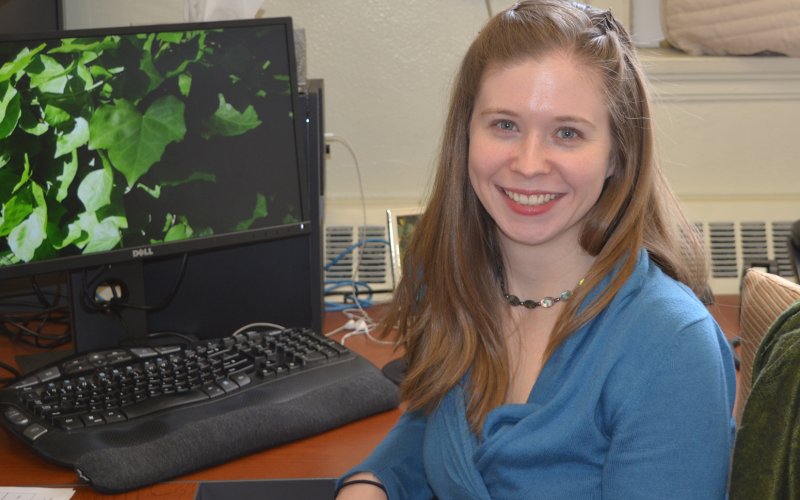5 Questions with Margaret Gullick

ALBANY, N.Y. (April 5, 2022) — The Center for Human Services Research (CHSR) at UAlbany is dedicated to developing empirically-based knowledge to improve the design and delivery of services that address social issues and meet community needs. For the past 30 years, the center has conducted evaluation research and designed information systems to inform policymakers and service providers across a broad spectrum of fields.
CHSR Director Margaret Gullick joined CHSR in 2017 as a researcher on the Healthy Families New York project. Appointed director in 2021, Gullick holds a bachelor’s degree in psychology and history from Wesleyan University and earned her PhD in cognitive neuroscience from Dartmouth College. Gullick and CHSR recently were approved to release a series of reports evaluating the New York State Medicaid Redesign Team’s Supportive Housing Initiative, in which they were able to demonstrate significant reductions in Medicaid and cross-sector costs after enrollment, even after comparison to a matched control group.
Before making her way to CHSR, Gullick was a postdoctoral research associate for the Developmental Cognitive Neuroscience Lab at Northwestern University and the Brain Development Lab at the University of Texas at Austin, where her research focused on examining how children’s educational outcomes are impacted and predicted by individual differences in brain structure and function, socio-economic status, and skill, using behavioral and brain imaging methodologies. This work has been published in journals such as Developmental Science, Journal of Cognitive Neuroscience and Learning and Individual Differences.
What is the Center for Human Services Research?
CHSR is a University research center focusing on social service evaluation for a broad spectrum of nonprofits, service organizations and state agencies serving vulnerable and marginalized populations. We aim to improve the design and delivery of services addressing social issues and community needs through informative, accurate and meaningful evaluation research and information system design. CHSR areas of inquiry and expertise cover a wide range of topics including behavioral health services; children, family and elder services; criminal and juvenile justice; education and early childhood development; equity-focused evaluation; and health and healthcare.
CHSR also includes the Data Management and Analytics Center, which provides research and analytic support to the UAlbany research community (find us at https://www.albany.edu/chsr/dmac/about.shtml and on twitter @DMAC_UAlbany).
You have previously conducted research on children’s educational outcomes. How has this area of focus impacted your work with the Center for Human Services Research?
Well, my methods are pretty different (CHSR doesn’t do functional or structural neuroimaging work!), but the underlying research skills are the same. We need to carefully consider how we’re designing research studies, recruiting participants, structuring the questions we ask clients and writing up and presenting the results to our audiences.
The statistics underlying functional magnetic resonance imaging (fMRI) aren’t so different from the statistics of a hierarchical regression. And in both cases, we’re really trying to learn how to achieve the best outcomes, whether that’s through developing individualized curriculum plans based on neuroscience or helping identify and address the needs in early childhood care and education, such as through our current Preschool Development Grant evaluation with the NYS Council of Children and Families.
We certainly hope that the work we do results in direct improvements for New Yorkers (and others). Programs may use our findings to better understand how their services support individuals and families and obtain funding to continue or expand their services. In addition, state-level partners use our results to inform policies and priorities around expanding successful initiatives or implementing new programs to address identified needs.
Either way, more people can access the services they need. For example, through a grant from the NYS Office of Victim Services, we analyzed secondary data, reviewed existing programs and surveyed and interviewed victims of crime and service providers to better understand the civil legal needs of victims of crime in New York. With our grant partners, we then used this information to help develop the New York Crime Victims Legal Help Network, which provides victims of crime with information about their rights and connects them with civil legal assistance.
What are some of the biggest challenges that the center is working to address?
All of CHSR’s work considers service provision to vulnerable populations, but we’ve lately been focusing more on programs that don’t just provide services but seek to promote equity by preventing future needs. For example, we’ve helped Albany County develop an equity agenda and partnered with UAlbany to conduct a self-study of the barriers to students of color in STEM, in preparation for work to actively address these barriers.
And of course, our longstanding work as the primary evaluator for Healthy Families New York is really about helping prevent future child abuse and neglect and building self-sufficiency through a primary prevention program.
You majored in history at Wesleyan. If there’s a moment in history that you could go back and witness live, what event would it be?
If I could be assured of being at a safe distance, it would be neat to confirm that the 1898 sinking of the Maine was really due to a coal bunker fire! But otherwise, I’ve got a real soft spot for medieval British history, so getting to watch the Battle of Hastings would be pretty awesome.
What’s something most people wouldn’t know about you?
Fun fact: I worked as a bartender one summer during college, and still enjoy mixing up cocktails, though I’m not very good at naming new drinks! Two recent favorites: tequila, a dash of triple sec, cranberry juice, honey syrup, and a sprig of smoked rosemary; and gin, grapefruit juice, green tea simple syrup, and a bit of muddled lemongrass paste. Let me know if you have any good ideas for what to call them.




